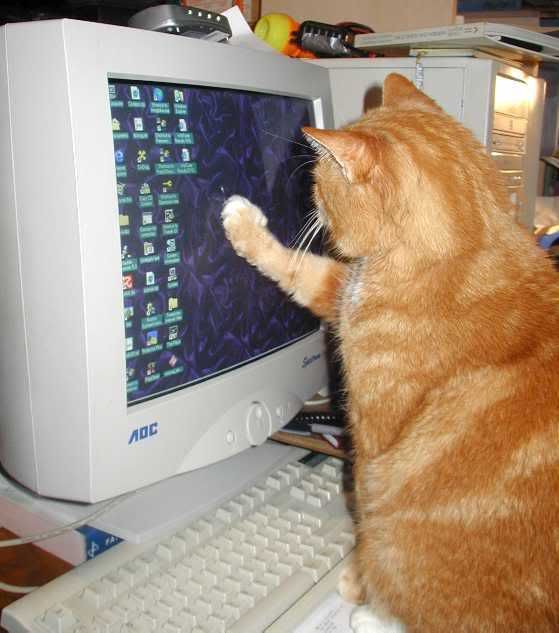|
|
Post by TheWallsScreamedPoetry on Jan 22, 2005 9:28:24 GMT
Other Voices TourThe Doors book smaller venues for their first tour without Jim Morrison since it is impossible to predict the publics reaction to such a tour.In addition they are outright opposed to playing big halls that had become such a scene under Jim. The superior acoustics and more intimate settings of the smaller hall appeal to them.
The performances during this tour always start with an anticipatory edginess from the audience who don't know what to expect from the band without Jim. Their concerns are quickly alleviated as the band progress through their first few songs. It is obvious that the musicians are proficient players who have adjusted to their loss and generated a cornucopia of new material that unmistakably defines them.
Manzarek later comments on that first tour.
"As you can imagine it was a little strange but the audience was warm and receptive. Thankfully most of them came with an open mind to see us and not for any seance during which we would try to raise a ghost. I've got to say that we are most happy and grateful with the way in which the audiences have accepted us."
Roy Carr: 'People Must realise It. Jim Is Dead'.
NME February 17th 1972.November 12th 1971, Pershing Municipal Auditorium. Lincoln Nebraska.Opening night of this first Doors tour without Jim Morrison shows great promise for the trio which is accompanied by Bobby Ray on rhythm guitar and Jack Conrad on bass. Ray Manzarek plays exceptionally well.
The Lincoln Journal comments:
"Keyboard man Ray Manzarek deserves the star for his dressing room for his performance on Friday evening at Pershing Auditorium. He is super talented on both organ and piano. When he tears into the blues he really is a superstar.
Holly Spence. Lincoln Journal November 13th 1971.
They open with a solid version of 'Tightrope Ride' and other highlights include 'Variety Is The Spice Of Life', 'Ships w/Sails' and 'Hang On To Your Life'
The show is promoted by old friend Rich Linnell.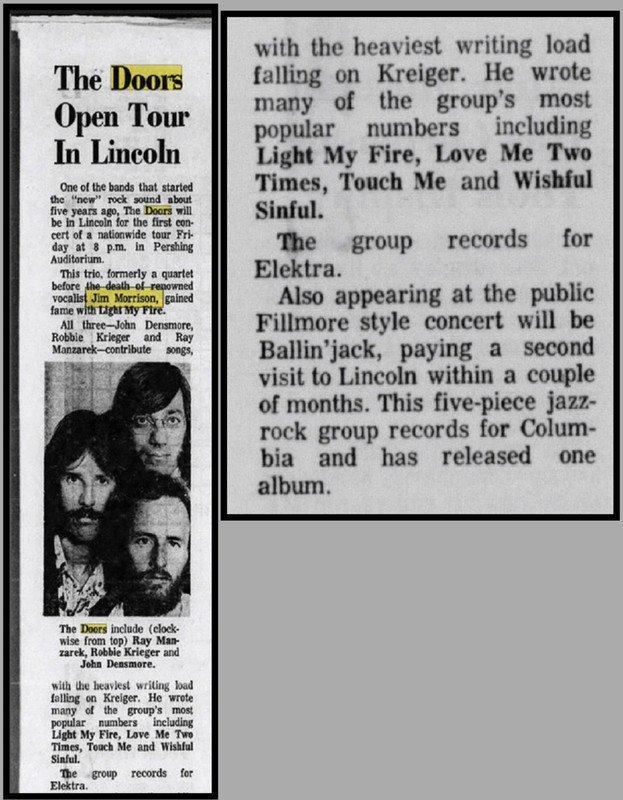 7-11-1971 Lincoln Journal Star NE 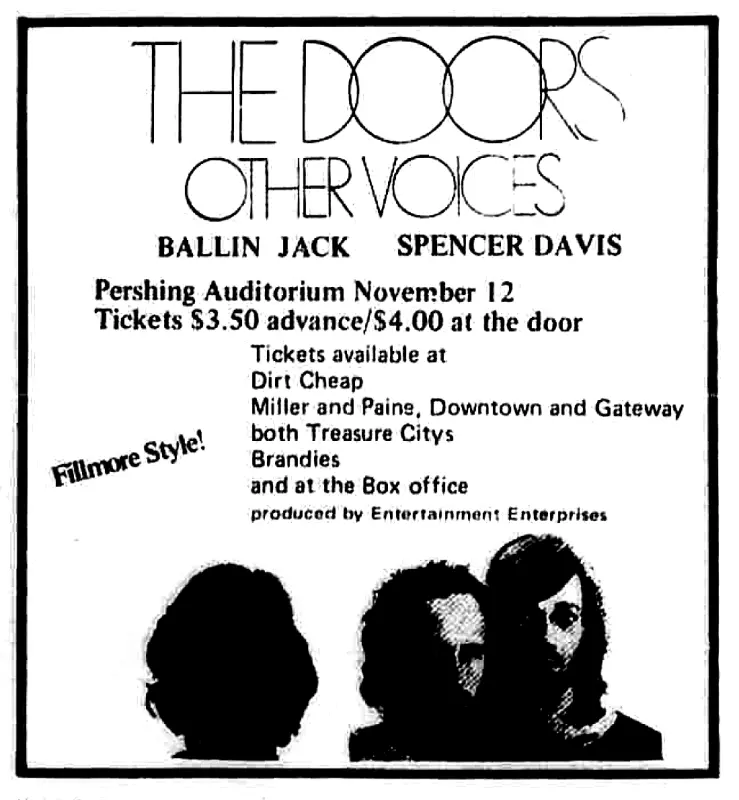 11-10-1971 Daily Nebraskan Lincoln NE 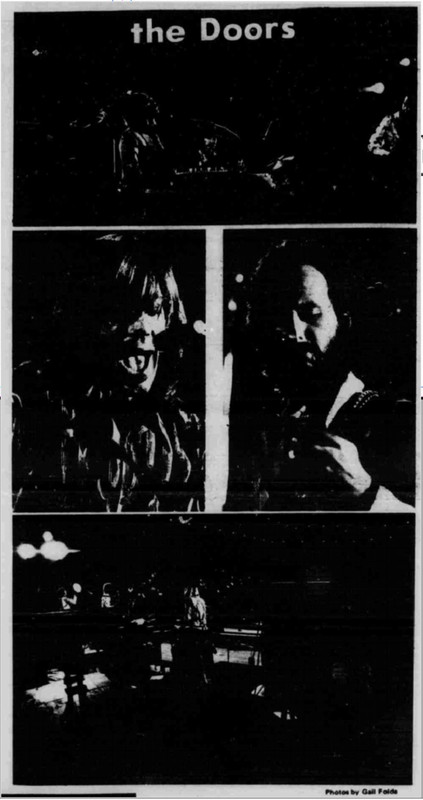 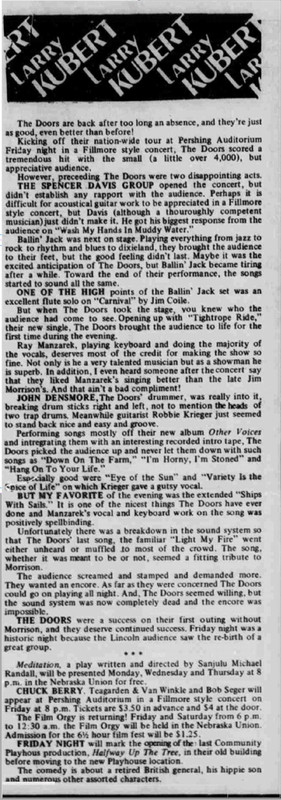 15-11-1971 Daily Nebraskan Lincoln NE  13-11-1971 Lincoln Journal Star NE November 13th Augsburg College, Melby Hall, Minneapolis. MN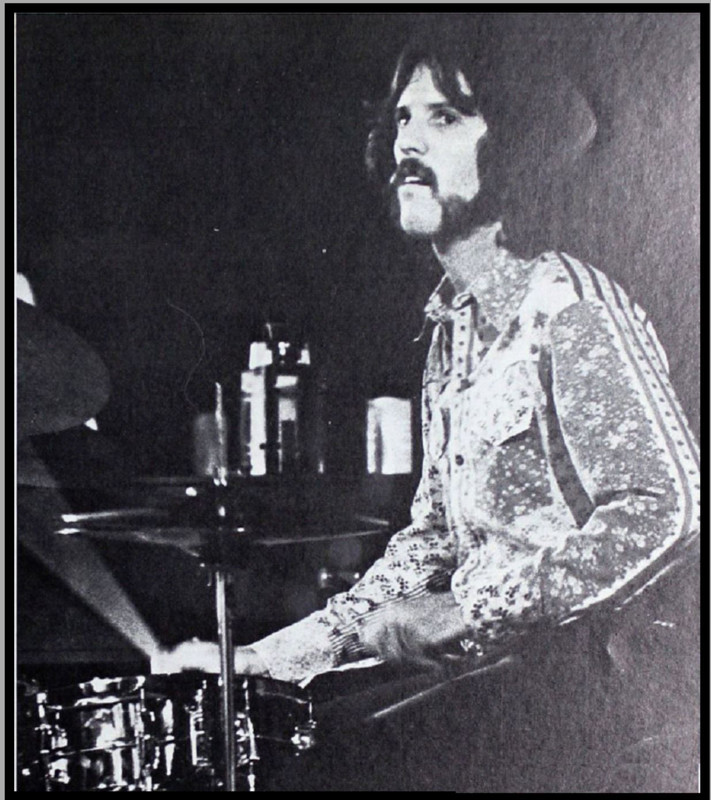 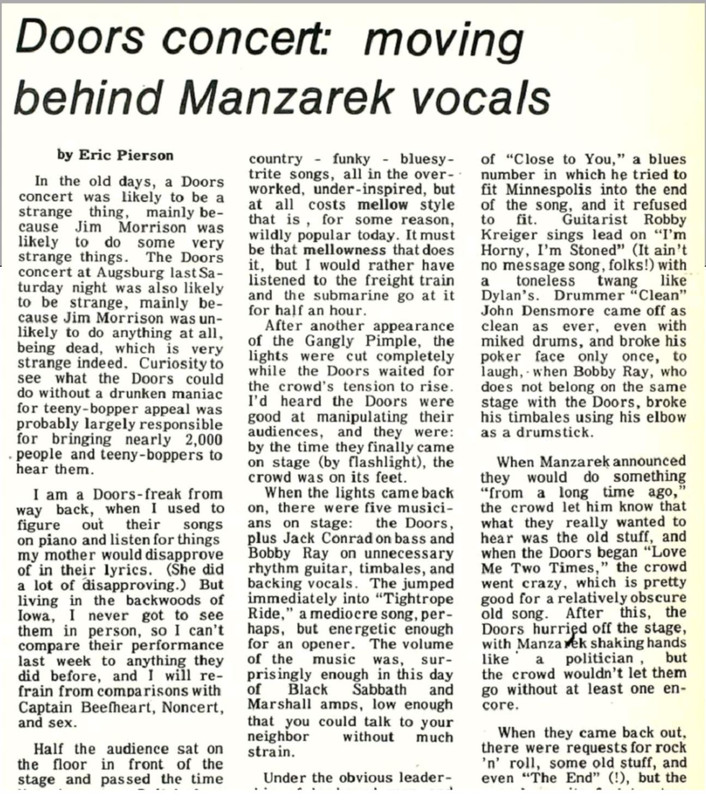  19-11-1971 The Daily Mac College Newspaper  7-11-1971 Minnesota Star MN 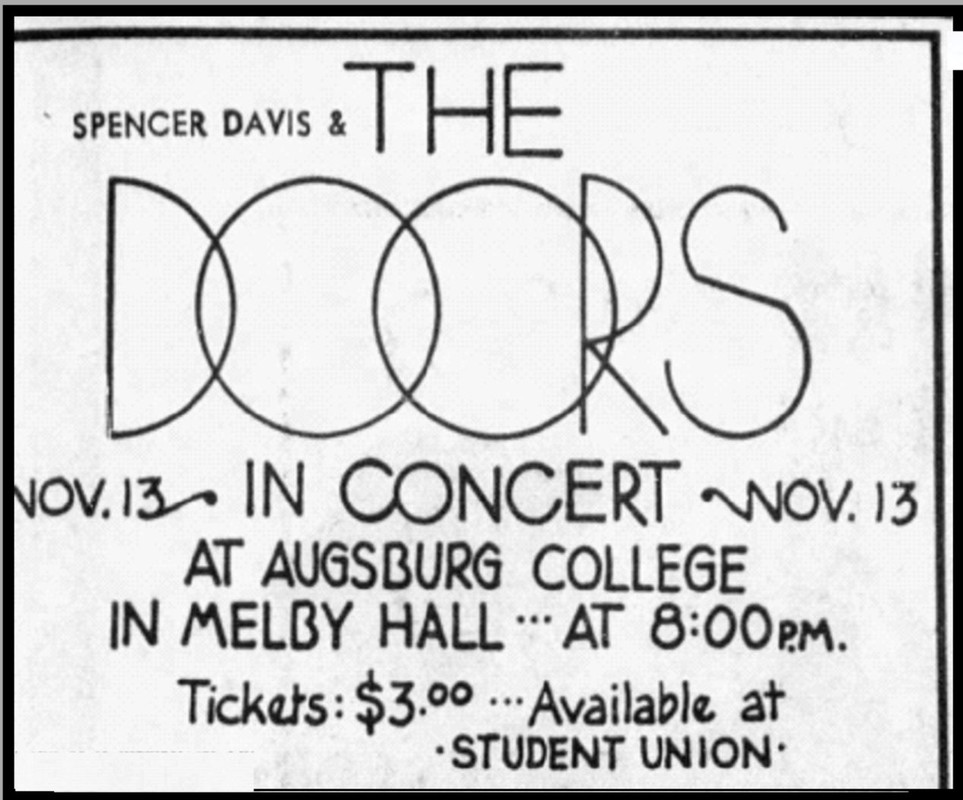 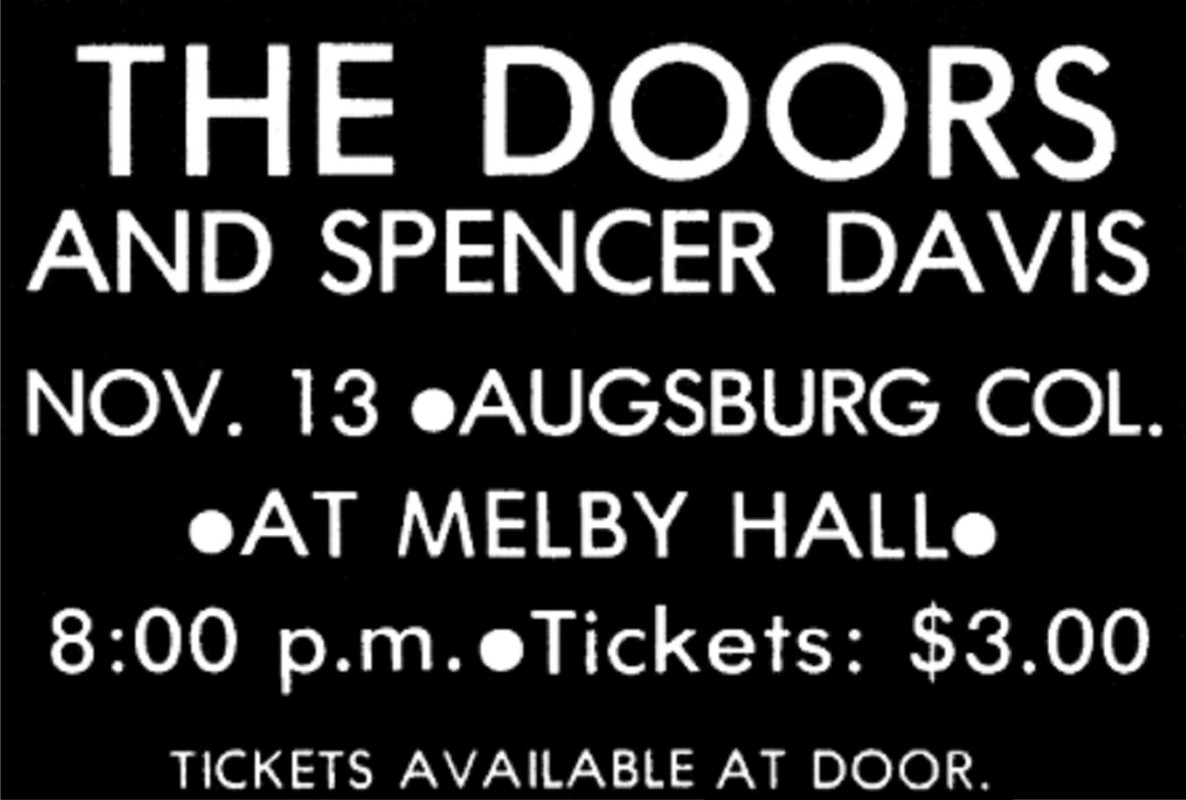 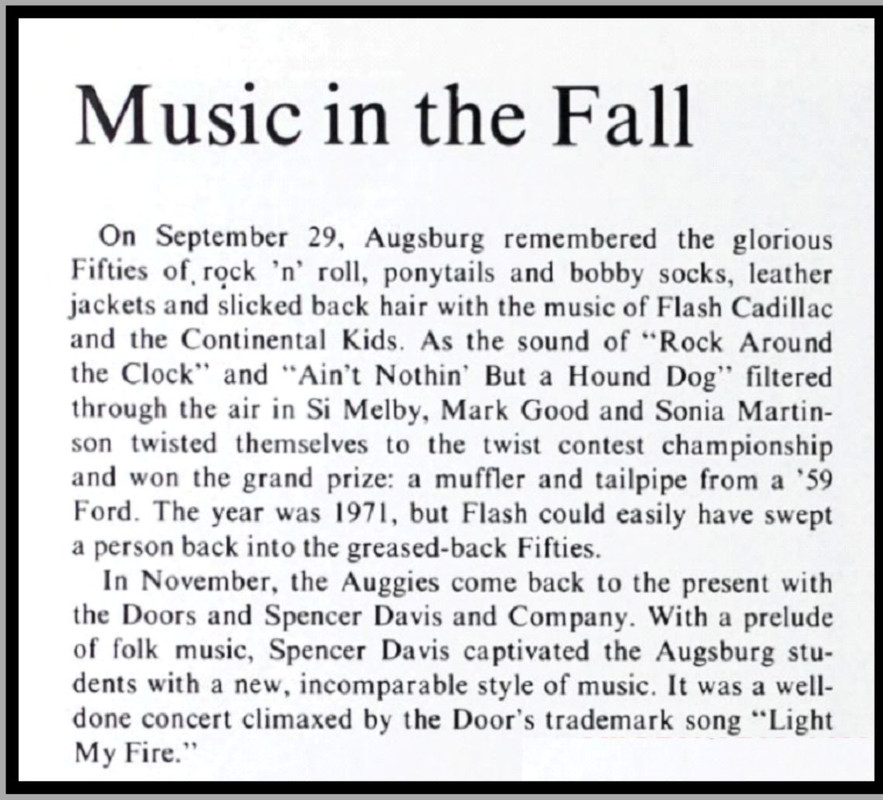 Augsburg College 1971 yearbook entry. 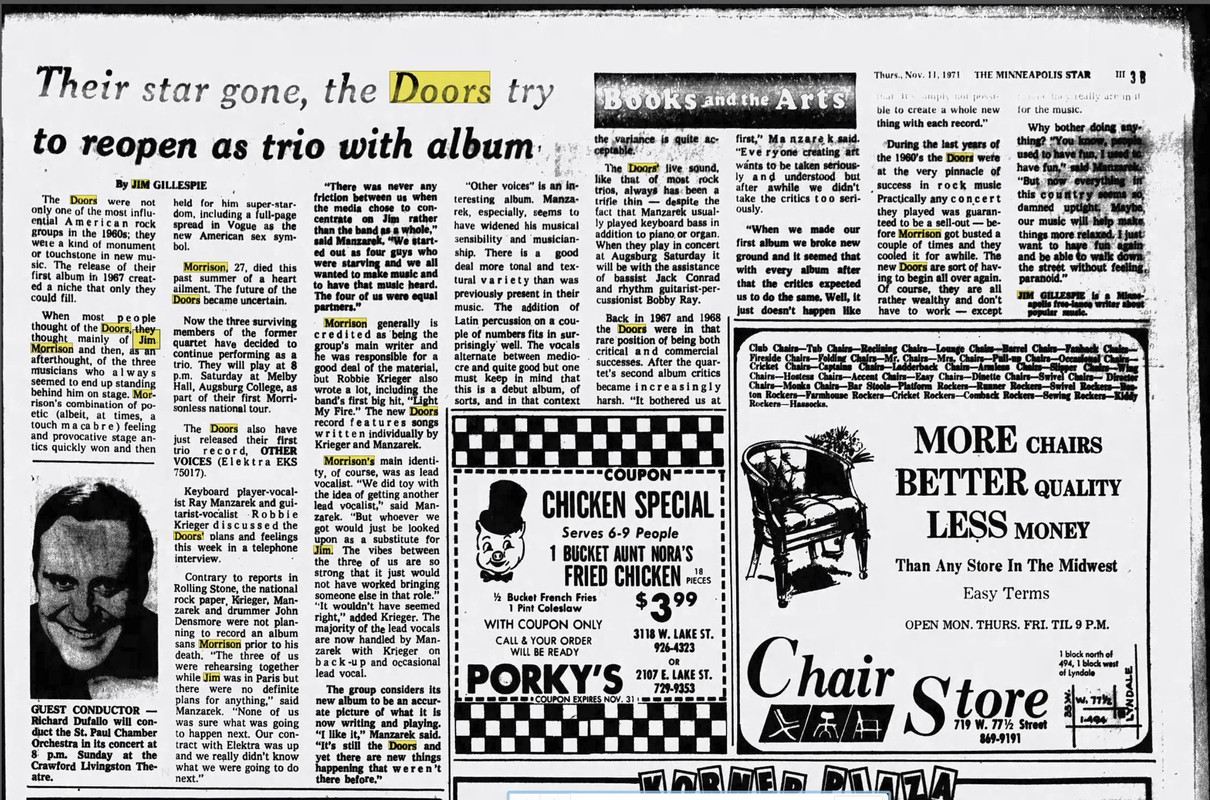 11-11-1971 Minneapolis Star, Minnesota November 14th 1971, St Lawrence Market. Toronto Canada.The Doors performance in Canada goes exceptionally well despite the somewhat sparse attendance.
The band is in fine shape and delivers the distinct impression that even without Jim they are still a band to be reckoned with.
On The Road November 17th Ottawa Civic Centre, Canada.The Canadian leg does not go well attendance wise as Toronto has a low crowd November 17th Ottawa Civic Centre, Canada.The Canadian leg does not go well attendance wise as Toronto has a low crowd
and this night in Ottawa is CANCELLED DUE TO POOR TICKET SALES   16-11-1971 The Daily Citizen Ottawa Canada The WackersThe Wackers singer guitarist Mike Stull was actively sought by The Doors as a replacement for Jim Morrison whilst Jim was still alive. He eventually ended up with Robby and John in their 2nd Butts Band. November 18th Peace Bridge Centre, Buffalo, New York.Adjacent the International Peace Bridge between US and Canada. The Wackers support and feature Mike Stull who was touted by his manager Bill Siddons to replace Morrison before he left for Europe. Stull would eventually become a member of The Butts Band MK2 with Densmore & Krieger in 1975.   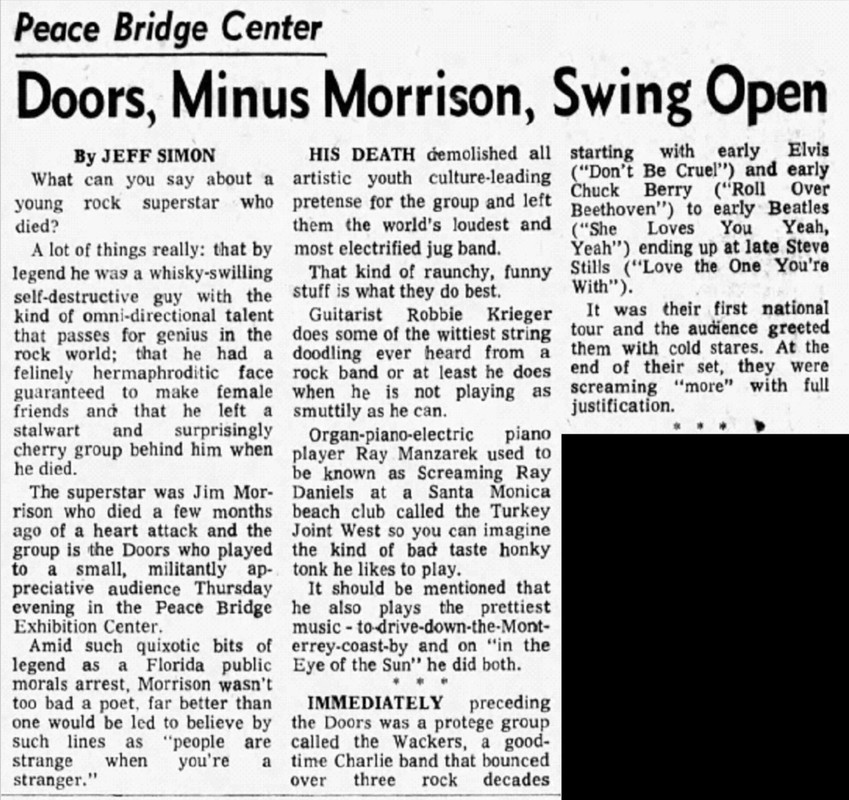 19-9-1971 Buffalo Evening News NY November 19th The Carousel, Schenectady, NY..CANCELLED November 20th East Town Theatre, Detroit, Michigan.  24-11-1967 Detroit Free Press MI November 22nd Boston Music Hall, Massachusetts. 14 10 71 Palm Beach Post FL 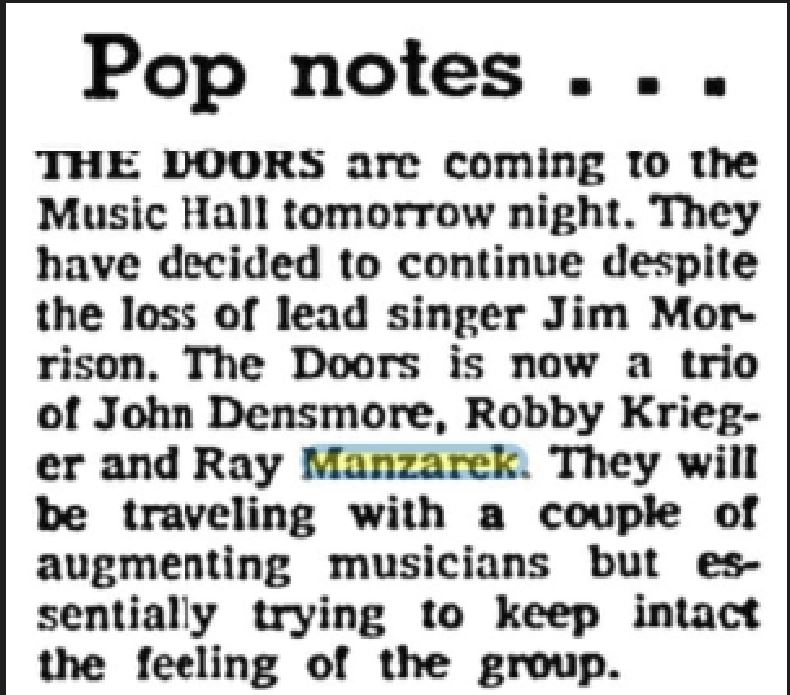 21-11-1971 Boston Herald MA  Doors On The Road.
|
|
|
|
Post by TheWallsScreamedPoetry on Jan 22, 2005 9:33:58 GMT
November 23rd 1971: Carnegie Hall, New York City. 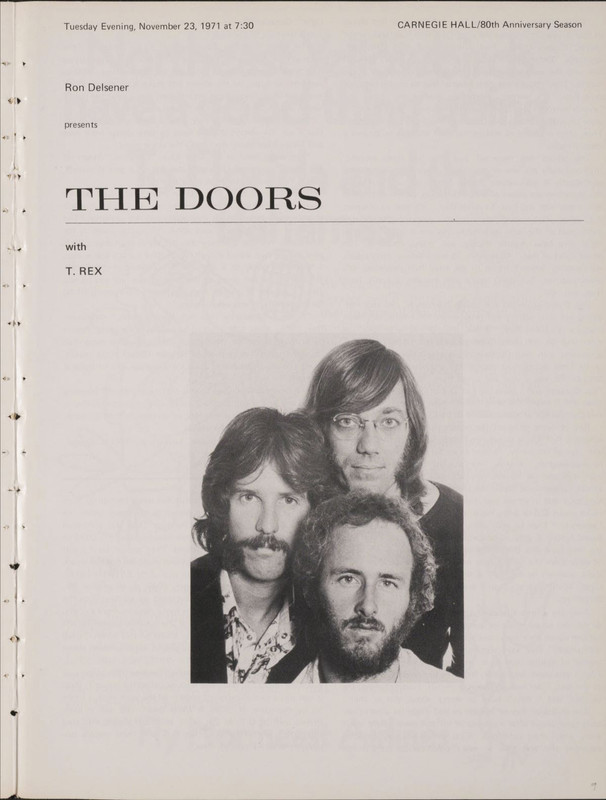 Odd as one poster says The Wackers were the support and the other says support was T Rex. Odd as one poster says The Wackers were the support and the other says support was T Rex.
I can't imagine that went down well with Doors fans. No Jim and Marc Bolan. Probably T Rex were third on the bill. 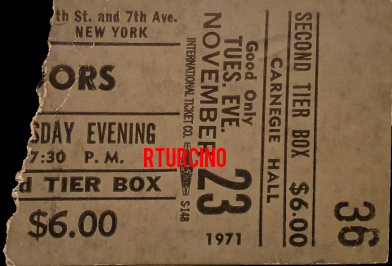 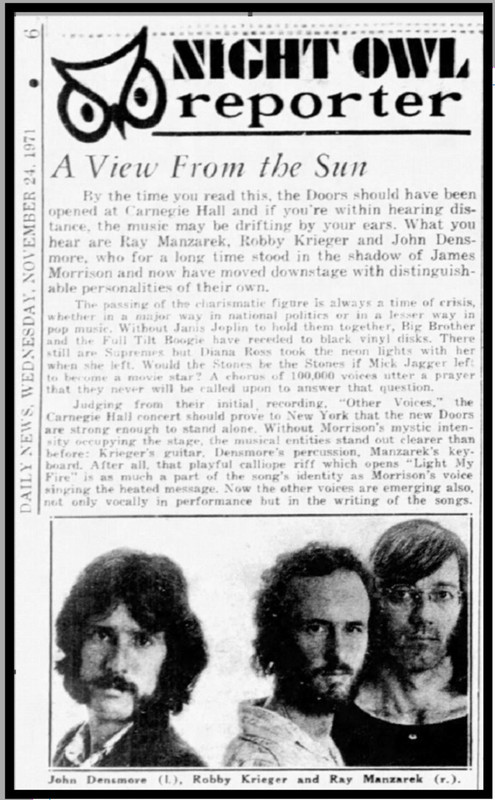 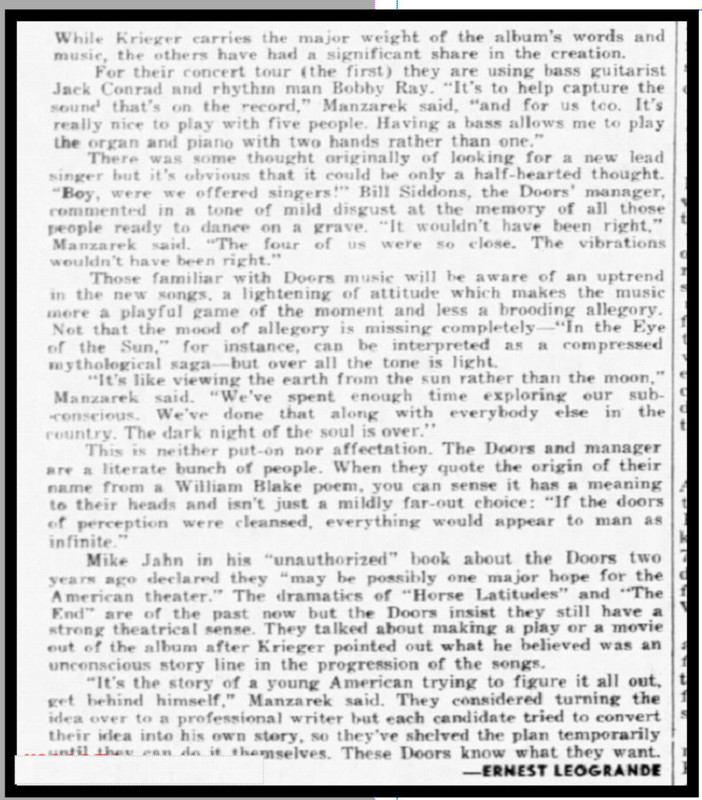 24-11-1971 New York Daily News NY 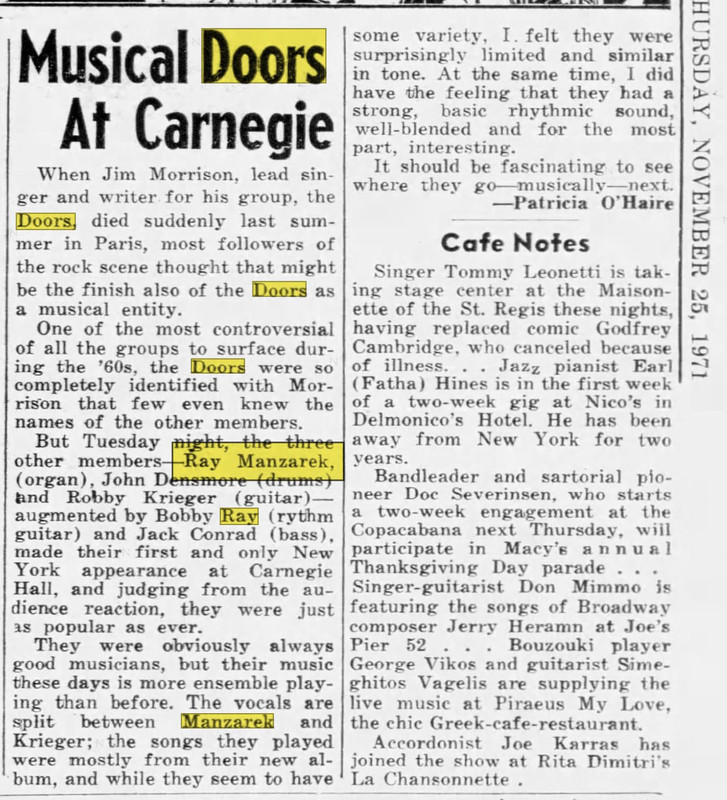 25-11-1971 New York Daily News The Doors highly touted appearance at New York’s prestigious Carnegie Hall is not only one of the highlights of the halls season but is probably one of the best shows The Doors ever perform without Jim Morrison.
After opening with an explosive version of ‘Tightrope Ride’ they proceed directly into a bustling version of ‘Variety Is The Spice Of Life’ later ‘In The Eye Of The Sun’ features some mesmerising keyboard work from Ray Manzarek particularly during the instrumental passage, which delivers numerous eerie overtones reminiscent of ‘Riders On The Strom’.
They conclude ‘Sun’ with frequent high spirited references to New York City which are embraced with appropriate cheers from this stronghold of Doors fans.
Tonight even the peculiarly ‘I’m Horny I’m Stoned’ is highlighted with some feverish guitar sequences from Robby Krieger.
Although ‘Hang On To Your Life’ commences as a fairly routine version of the song towards its conclusion the entire band suddenly vaults into an exceptional jam that so vividly invokes the spirit of Jim Morrison that one can readily imagine Jim’s high pitched howls fuelled by the intensity of the instrumental rising into the air.
The Doors then step back into their previous repertoire with a lively ‘Love Me Two Times’ and a very rock and roll flavoured ‘Close To You’.
Following that Ray introduces Tony Glover who had sat in with The Doors on some memorable nights in Minneapolis and the band breaks into a very blues influenced version of ‘Good Rockin’. Glovers steady locomotive harmonica style adds some exquisite flavour to this rock classic. The band closes with the highly anticipated ‘Light My Fire’ which builds into a remarkably energetic instrumental passage followed by a vigorous final chorus that concludes to tumultuous cheers and applause from the enthusiastic audience. The Doors then return with Tony Glover to bring the superb evening to a close with a salty version of ‘Hoochie Coochie Man’.The Doors On The Road.  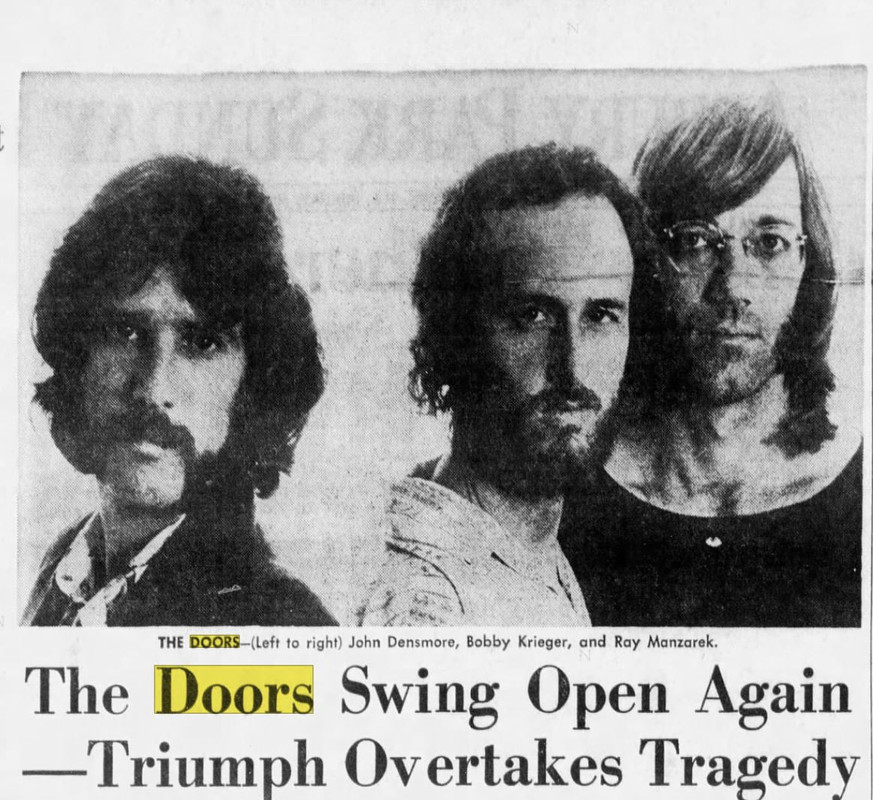  28-11-1971 Asbury-Park-PressSet ListTightrope Ride
Variety Is The Spice Of Life (Cut)
In The Eye Of The Sun
I'm Horny, I'm Stoned
Hang On To Your Life
Love Me Two Times
Down On The Farm
Close To You
Ships With Sails
Good Rockin'** Featuring Tony Glover on Harmonica
Light My Fire
Hoochie Coochie Man** Featuring Tony Glover on Harmonica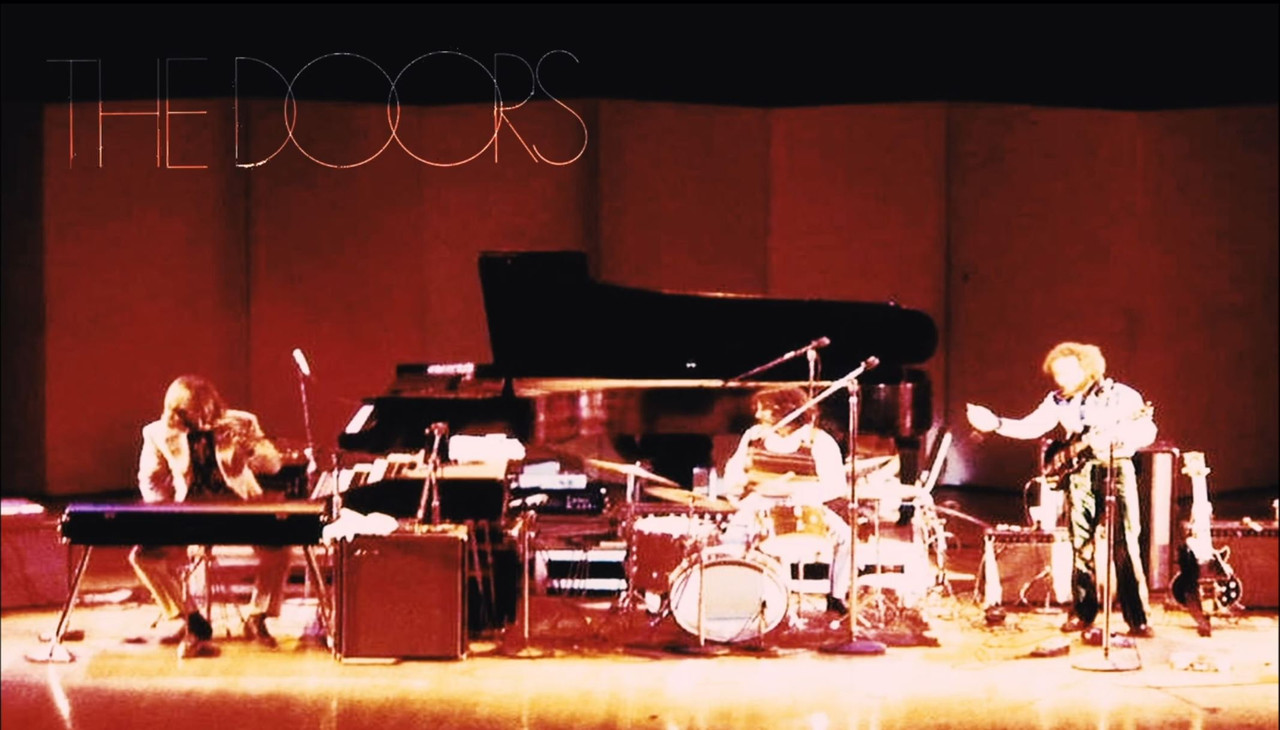 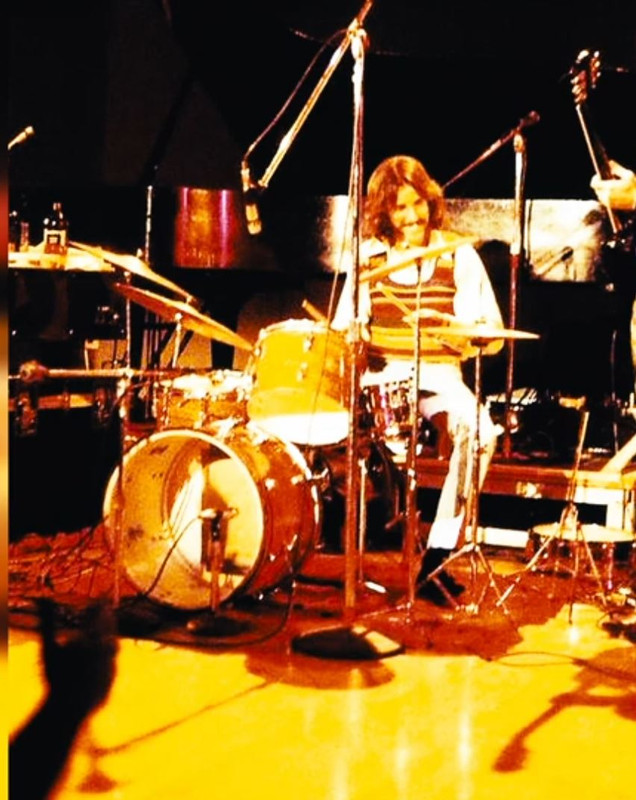 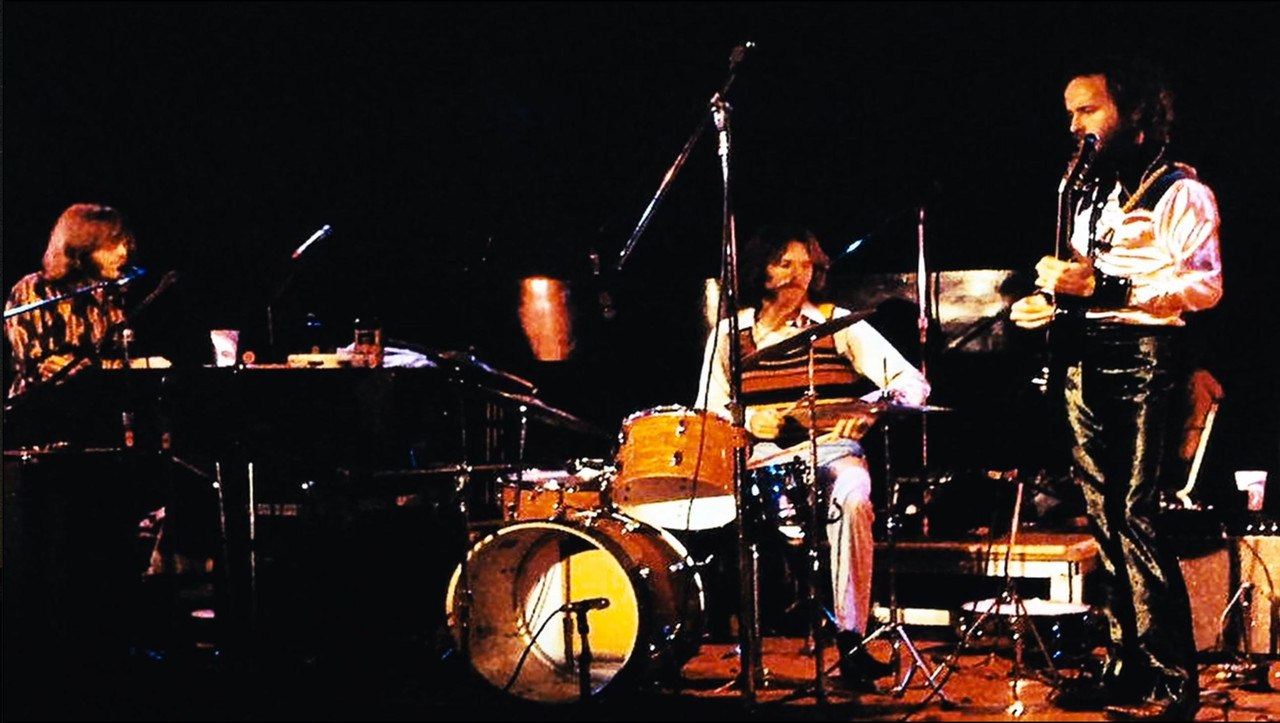 ### The support for this night is The Wackers who feature singer guitar player Mike Stull who was approached about fronting the group after Jim announced he was leaving the band and left for Paris.“One of the most eagerly awaited concerts of the NY Fall was a knockout at Carnegie hall. The Doors appearing in Gotham for the first time without the late Jim Morriosn were exciting all the way. “ Variety Magazine December 1st 1971. ### The support for this night is The Wackers who feature singer guitar player Mike Stull who was approached about fronting the group after Jim announced he was leaving the band and left for Paris.“One of the most eagerly awaited concerts of the NY Fall was a knockout at Carnegie hall. The Doors appearing in Gotham for the first time without the late Jim Morriosn were exciting all the way. “ Variety Magazine December 1st 1971.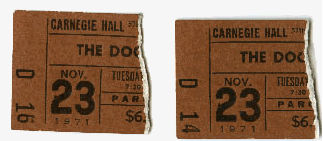 "No audience would let them get away with a complete about face. Jim Morrison's image is still very much with them musically and spiritually. Ray Manzarek who looks to calm for it all is the new leader and he wears the role with enough reluctance so that it is readily acceptable. His keyboards are mightier than ever and the sum total of the groups other voices convey much of the richness that made Jim so unique. The new music bears Jim's mark but this is both expected and welcomed. Morrison was and forever will be a Door. Thats the way the crowd want it. Thats the way fate planned it. "No audience would let them get away with a complete about face. Jim Morrison's image is still very much with them musically and spiritually. Ray Manzarek who looks to calm for it all is the new leader and he wears the role with enough reluctance so that it is readily acceptable. His keyboards are mightier than ever and the sum total of the groups other voices convey much of the richness that made Jim so unique. The new music bears Jim's mark but this is both expected and welcomed. Morrison was and forever will be a Door. Thats the way the crowd want it. Thats the way fate planned it.
Manzarek-Krieger-Densmore they are one and they are three. They are the audience and the audience is them. Full Circle, round circle beautiful circle. Death is not the end when life is strong"
CashBox December 4th 1971.“The group emphasised its instrumental performance over the vocals and lyrics by playing lengthy numbers from ‘Other Voices’ at extremely high volume. Were it not for the refined talents of John Densmore, Ray Manzarek and Robby Krieger The Doors decision to retain their name and continue as a trio could have proven fatal. As it stands the group fronts an impressive attack that could be strengthened by turning down the volume a bit and incorporating more familiar material into the repertoire.”
John Kogel ‘Doors Other Voices Weaken Carnegie Show’.
Hofstra University Chronicle December 2nd 1971."I had re signed Ray, Robby & John to a multi record deal, my way of showing them it wasn't all Jim and saying thank you with Warners money' {Elektra had just been sold to Warners which had become WEA (Warner/Elektra/Asylum)} Thier first album was Other Voices and to launch the record and the new reality we put on a Carnegie Hall concert. Carnegie Hall was big enough to hold a crowd and small enough to go three quarters of the way back to intimacy. With Ray doing most of the vocals The Doors wowed the sell out audience of soaked in brine Doors fans."
Jac Holzman from Follow The Music. November 24th 1971: Irvine Auditorium University of Pennsylvania, Philadelphia. The Doors performances go well this evening demonstrating their musical abilities aptly. The evening is light and open. The Doors performances go well this evening demonstrating their musical abilities aptly. The evening is light and open.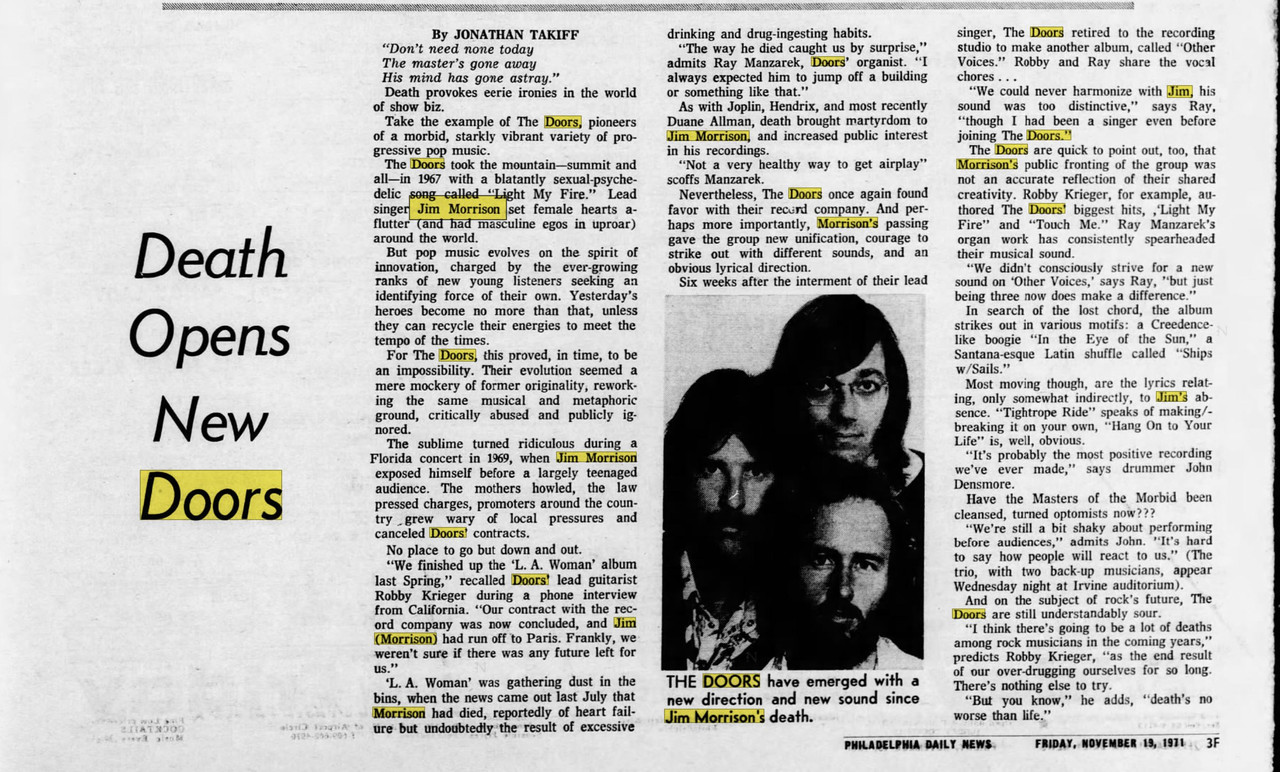 19-11-1971 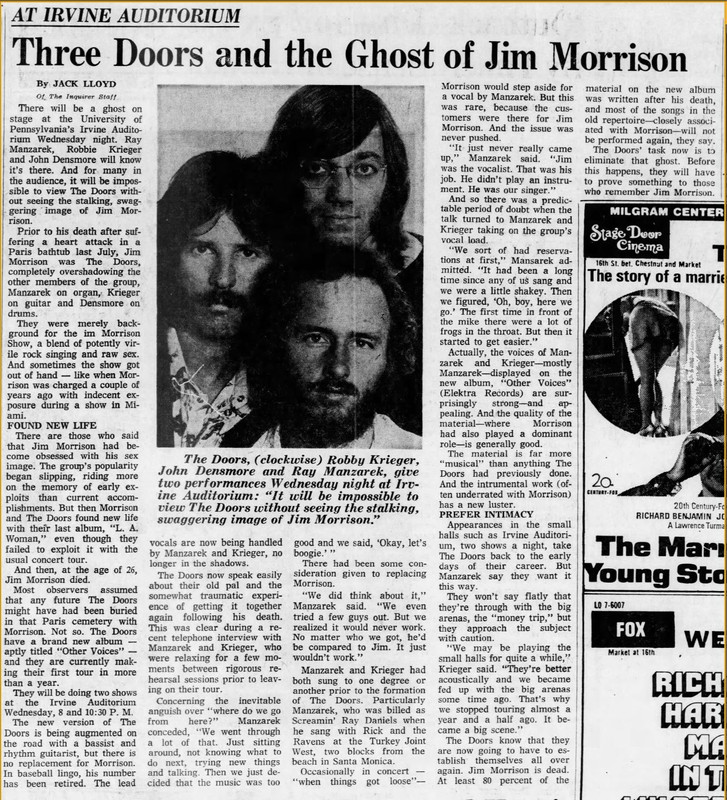 21-11-1971   26-11-1971 Philadelphia Inquirer PN 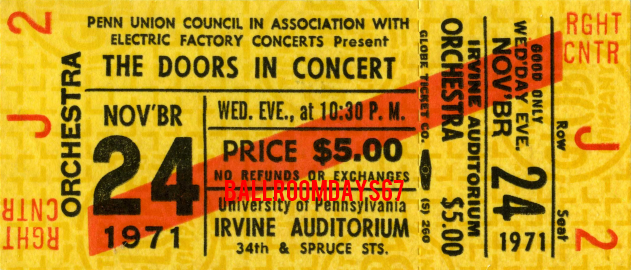 November 26th 1971: Hollywood Palladium Los Angeles November 26th 1971: Hollywood Palladium Los Angeles . the first gig in LA without Jim was also long time former roadie equipment genius now Road manager Vince Treanor’s last with The Doors….and the band pays tribute to him for all his efforts over the years after playing 'Hang On To Your Life' from the new album. 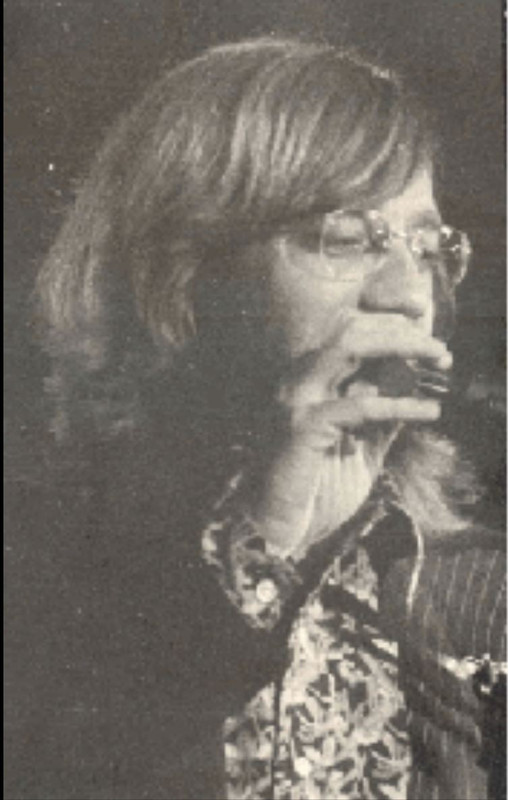 Set List Set List
Tightrope Ride
Variety Is The Spice Of Life
In The Eye Of The Sun
I'm Horny, I'm Stoned
Hang On To Your Life
Love Me Two Times
Down On The Farm
Close To You
Ships With Sails
Hoochie Coochie Man 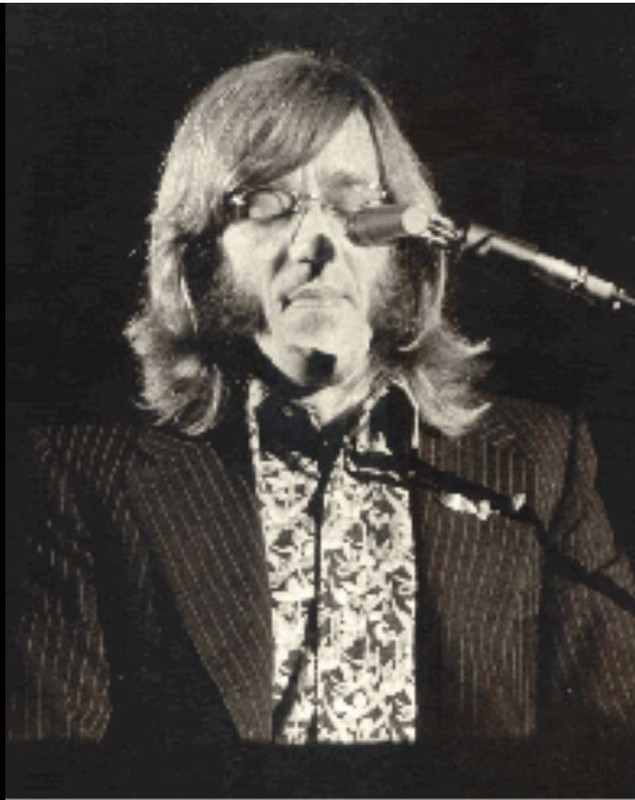 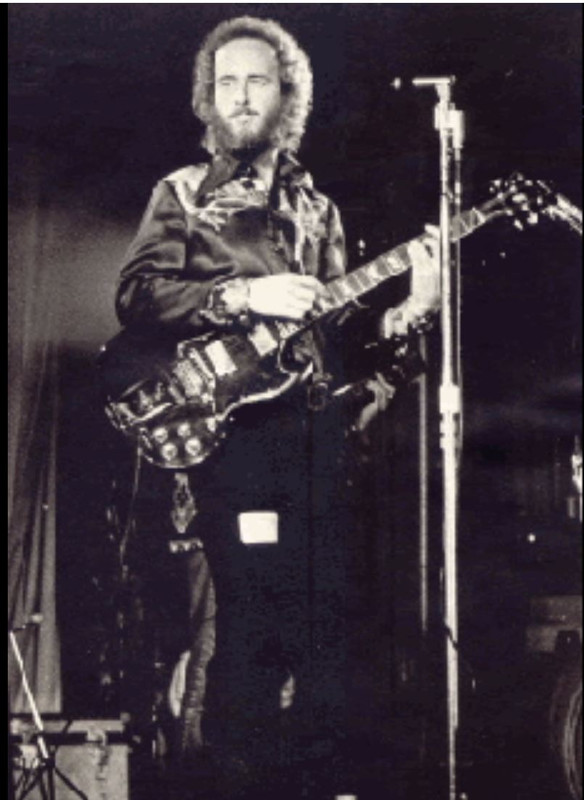        “The Music of The Doors still deals with apocalypse but now the group tends to be doing a rueful little dance along the edge of the abyss. The death of Jim Morrison seemed to make survivors Ray Manzarek, Robby Krieger and John Densmore a lot freer in their musicianship and more consistently able to express their meta-physical outlook with touches of cosmic humour. Onstage minus Morrison they have obviously lost something in fiery charisma at this early phase of their new career. But their return to LA set showed craftsmanship of a high order and a touching eagerness to communicate all out. The Doors trio is sure to remain a major force in rock for many more years!” “The Music of The Doors still deals with apocalypse but now the group tends to be doing a rueful little dance along the edge of the abyss. The death of Jim Morrison seemed to make survivors Ray Manzarek, Robby Krieger and John Densmore a lot freer in their musicianship and more consistently able to express their meta-physical outlook with touches of cosmic humour. Onstage minus Morrison they have obviously lost something in fiery charisma at this early phase of their new career. But their return to LA set showed craftsmanship of a high order and a touching eagerness to communicate all out. The Doors trio is sure to remain a major force in rock for many more years!”
BillBoard December 1971.“As far as most of the audience are concerned the group could do no wrong and to be honest they were good….damn good. The five men together with engineer/producer Bruce Botnick who mixed the show delivered one of the tightest sounds you’d want to hear. They don’t have to rely on old material…the set was well placed and the excitement level was consistently high. Other Voices is like a rough sketch of the kind of finished masterpiece they can create on stage. It’s a new group and it’s an exciting group. And it is a group that I would even go out of my way to see again. And coming from a reviewer who more often than not has to force himself to go to a concert that is quite a compliment.”
Chris Van Ness. LA Free Press December 3rd 1971.December 2nd 1971: Berkeley Community Theatre. Berkeley CA.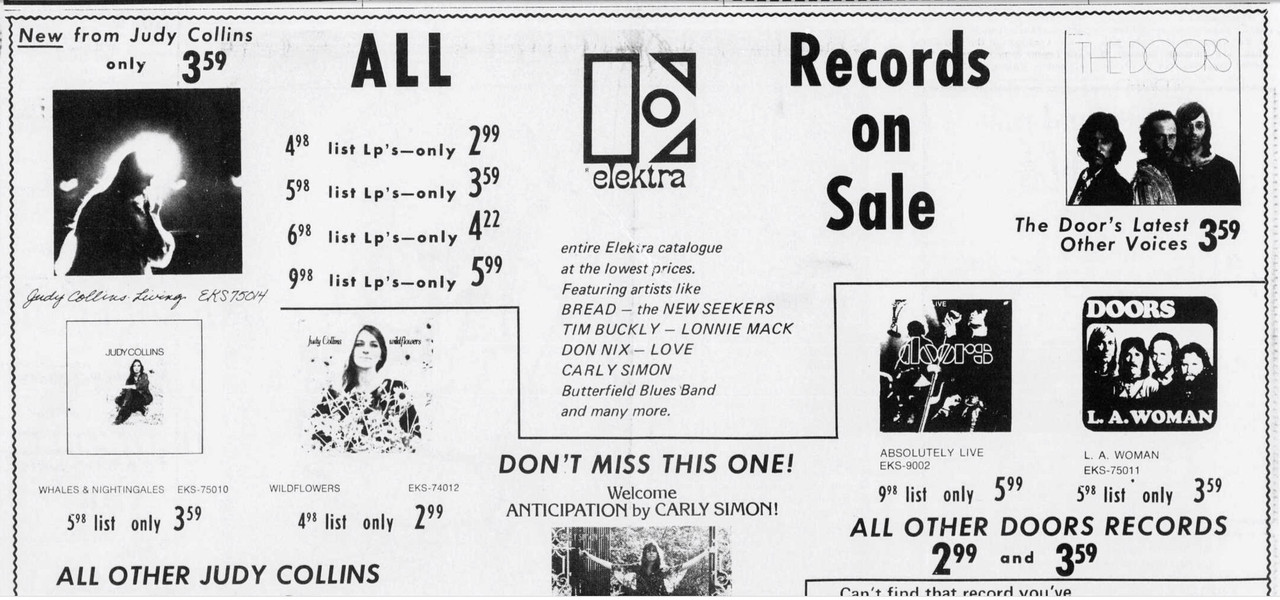 2-12-1971 Stanford Daily. Student Newspaper.  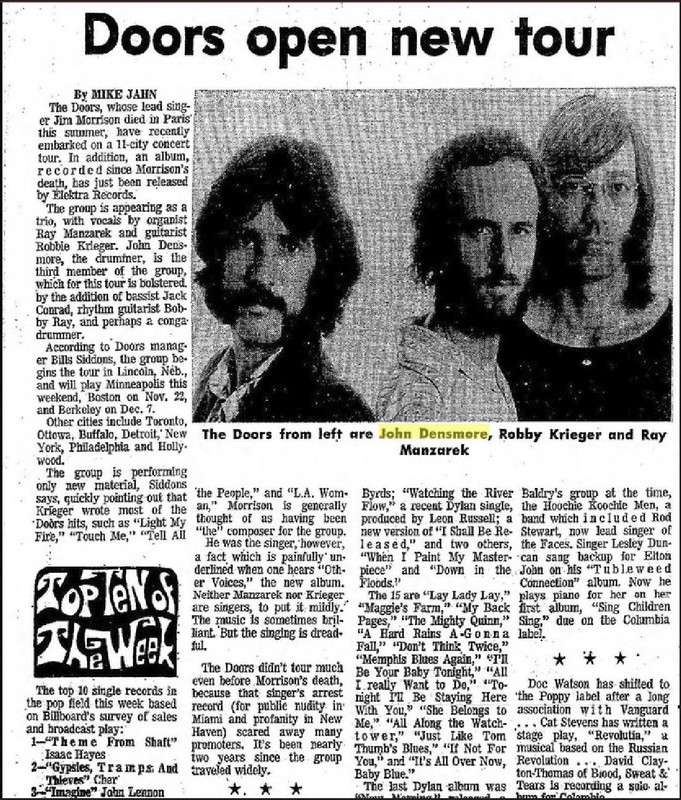 13-11-1971 Oakland Tribune CA 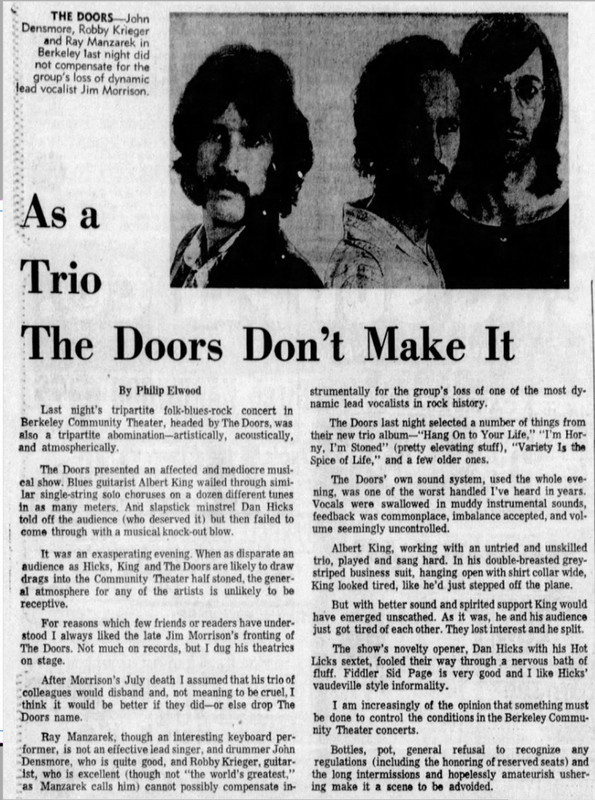 3-12-1971 San Francisco Examiner CA     This concert is unfortunately marred by sound difficulties that affect all three bands. The Doors seem to be slightly uncomfortable with the sole performance in the Bay area sounding much more like they did with Jim than in recent performances. They even pull back on thier instrumentals during songs like 'Light My Fire' as if half expecting to see Morrison suddenly appear offstage engaging in some of the craziness he loved to enact during the instrumantal passages. This concert is unfortunately marred by sound difficulties that affect all three bands. The Doors seem to be slightly uncomfortable with the sole performance in the Bay area sounding much more like they did with Jim than in recent performances. They even pull back on thier instrumentals during songs like 'Light My Fire' as if half expecting to see Morrison suddenly appear offstage engaging in some of the craziness he loved to enact during the instrumantal passages.
|
|
|
|
Post by TheWallsScreamedPoetry on May 8, 2011 15:25:36 GMT
It is Doors music mainly due to its trappings....they still are The Doors but without a cause or passion. It is obvious that Jim Morrison was more than just a singer....
With that opinion from Rolling Stone at the back of thier minds The Doors decided to take to the road once again both to promote the new album but also to demonstrate that The Doors minus Jim Morrison did not spell diasaster. To help with this they recruited two supplementary musicians.
Jack Conrad on bass who according to John:
'worked with Helen Reddy and writes a lot of stuff with her....had some hits on the charts'...
and Bobby Ray on rythm and additional percussion:
'He was an old friend of ours from LA. He's played bass with Donovan on 'Sunshine Superman' and had been on the road with The Mamas & The Papas. I'd known him for quite a while and he'd toured with us before. The summer after he came with us he put out a solo album produced by Johnny Rivers'.
Robby Krieger.
The tour had a less than auspicious start with dates in Toronto and Ottawa pulling very small crowds but by the time they got to New York and Carnegie Hall via Lincoln Nebraska and Detoit it was standing room only and all along the line the reviews had been universal in thier praise of the concerts. It was evident that not only did the Other Voices material work better live (only 'Wandering Musician' was omitted) but as with the 'old' Doors the band itself was a different entity on stage.
The crowds tended to agree with the critics though again there were a fair number of the curious salted among the faithful. This audience reaction was most surprising as the new album aside the only other songs performed were 'Love Me two Times', 'Light My fire' and 'Good Rockin' Tonight' the old Elvis standard. Whilst the audience naturally acclaimed the golden oldies they also reacted well to the newer material.
Dispelling Ray's slight early reservations.....
I think its going to take people a little while to adjust to what we are doing....At first. I think it might be rather confusing for them....but little by little, if they just listen and dig the music!...'
From 'The Doors' by John Tobler & Andrew Doe.
"We sort of had reservations at first. It had been a long time since any of us sang and we were a little shaky. Then we figured. Oh Boy here we go.. The first time in front of the mike there were a lot of frogs in the throat. But then it astarted to get easier."
Ray Manzarek on the first tour without Jim.
'Three Doors & The Ghost Of Jim Morrison'
Philadelphia Inquirer November 21st 1971
Premier Guitar Interview
Q) What was it like for the Doors to continue as a three-piece band after Jim died?
RK) I have to say it was tough not having Jim up front, but he had become so unpredictable and unreliable.
Ray and I had to take over lead vocals. After he was gone, we could actually make a set list and stick to it—but it wasn’t much fun. Jim’s onstage spontaneity was a big part of the Doors live experience.
The audiences were very cool about it, though.
We took along another guitar player named Bobby Ray, a friend of ours from LA, and a bass player named Big Jack Conrad—the first time we ever had a bass player onstage.
|
|
|
|
Post by TheWallsScreamedPoetry on Nov 9, 2011 16:31:59 GMT
Read the yellow bit   LINER NOTES FOR THE WACKERS' LP HOT WACKS By Richie Unterberger When the Wackers were recording their 1971 debut album Wackering Heights (also reissued on CD by Collectors' Choice Music), producer Gary Usher "told us that if it did well, meaning critically or sold a bunch of records or whatever, we could go someplace exotic to cut the next one," remembers singer-guitarist-songwriter Bob Segarini. "Exotic turned out to be Montreal. I thought, we're going to Canada? The record must have not done that good." But the Wackers would end up liking Montreal so much they would move there for several years. And Hot Wacks gave them the chance to record more music that properly reflected their harder-rocking live sound, even if disagreements over how to mix the end result would lead to the end of their working relationship with Usher. Wackering Heights had introduced a band that stood out as an anomaly on the early-'70s album-oriented rock scene with their affection for pop-folk-rock melodies and multi-part vocal harmonies, all owing much to the spirit that had driven the 1960s British Invasion. "The difference between Hot Wacks and the first album was that we started leaning a little more towards our live side," explains Segarini, who along with multi-instrumentalist Randy Bishop wrote most of the material on the album (though everyone in the Wackers made compositional contributions). "We wanted it to be a little rockier, a little more electric. Wanted a bigger drum sound and a bigger low end, and more electric guitars than acoustic guitar. I don't know if we were just succumbing to the fan reaction live, or whether we ourselves wanted to move away from the folky thing. 'Cause we were kind of disappointed in the first album, insofar as good friends -- people like [rock critics] Lester Bangs, Ben Edmonds, and Dave Marsh -- [were] going, 'I love the band, man, but the first record's a little wimpy.' You hear that stuff enough, and go, 'Okay, let's beef it up.' I like the sweetness of the first album, but I like the reach of the second album. We really pushed ourselves on Hot Wacks." Most of Hot Wacks was recorded in Montreal, Bob continues, "at a place called Le Studio, which was in a church across the street from the morgue downtown. That album was cut on two Trident 16-track boards imported from England, on 32 tracks. They had mechanically synced two 16-track machines so that we could record 32 tracks, which was unheard of in the day. The secret that came out years later, that they never told us, was the machinery never worked. Every morning at 5 A.M., two engineers would go in there and sync those two machines up by hand. It would take them six to eight hours. They did it every day, and never told us." Most of the record was done in Montreal (the sessions taking a mere six days, according to the original LP's back cover credits), and most of it was written by the Wackers. But the track singled out for the most attention was the one cover, and the one song that was not recorded in Montreal. Their version of John Lennon and Yoko Ono's "Oh My Love," from Lennon's Imagine, was cut at Wally Heider's Studio in San Francisco (the vocals for one other track on the LP, "Wait and See," were also done at the studio, though everything else on that track and the rest of the album was recorded in Montreal). Issued by Elektra as a single, it has subsequently appeared on numerous bootlegs, mistakenly billed as an unreleased Beatles version of the tune. "I just went, 'Okay, now, we're doing this as though the Beatles were,'" says Segarini. "We're full-goose bozoing this thing as a Beatle track. This is an exercise in fun. How would Lennon have recorded this song if the Beatles hadn't broken up? That was the premise." Continues Bob, "We even flew [engineer] Ritchie Moore into Wally Heider's to record that track, because he and Usher knew how to get the slowed-down bass and drum sound we wanted, with a ton of compression on it. So we record the song slightly fast with the tape slowed down so that when they slowed it down, it had much more weight to it. You'll notice that the tom-toms are going 'poom-poom' -- that's how you do that. Then they compressed the bejeezus out of the bass and drums. We put on the 12-string guitar and all that stuff, quadrupled the vocals to get that beautiful silk sound." An especially imaginative touch was supplied by koto player Kathie Kodama. "I'm thinking to myself, 'They wouldn't use a sitar on this because this is not a George [Harrison] influence,'" elaborates Segarini. "'This is a John [song]. John's married to a Japanese [woman]. Japanese instruments...koto!' So I find a koto player at the University of San Francisco. She was like 18 years old, and she had a koto, which is huge -- the thing is like eight feet long, it's got four strings, it's like somebody just stuck strings on a log. She shows up with her father, and it took the first three hours of the session to get her to play [the koto riffs on the track]. Her dad wouldn't let her play those notes, because they weren't the notes that are supposed to be played on a koto. It's a traditional instrument. In other words, not unlike the sitar, there are certain things you should be able to play on it, and certain things you shouldn't. So we had to retune the koto and talk her into doing that, and we did. She was talking to her dad in Japanese all day, reassuring him that it was okay, that their ancestors weren't going to turn into Easter eggs or anything. But I love the sound of it. It did exactly what we wanted it to do." The first time Segarini heard it on a bootleg "was on a ten-inch from Germany called The Guitar Is All Very Well and Good, John, But You'll Never Make a Living With It. Then it was on like 180 other bootlegs as the rejected Beatles version from Abbey Road, which, of course, it isn't. But that was neat. It was nice to be alongside John Lennon and Beatles songs on bootlegs." They'd also fooled their producer, Gary Usher, in a different way when they sent him their demos of material during pre-production for Hot Wacks. "Oh My Love" was the last one they sent, as Bob had only gotten a white label test pressing of Imagine with the original Lennon version "the night before from Federal Express. So we didn't have time to learn the song, 'cause I had to go to the post office in the morning. So I just put the record on, then we overdubbed guitars and vocals and sent it to Usher. I got a call from him -- 'that's the best song you ever wrote.' I went, 'Yep.' Still is!" he laughs. Other comparisons to the Abbey Road-era approach of the Beatles might have been sparked by side two of Hot Wacks, which -- like side two of Abbey Road -- was largely devoted to a medley of sorts. Aside from the opening track "Breathe Easy," the side consisted of a ten-a-half-minute continuous string of tracks, opened by "Time Will Carry On" and concluded by "Time Will Carry On (Won't It)." "Those were bits and pieces of songs that Randy and I hadn't finished," comments Segarini. "We were working on one of them. I was hitting a blank wall with this stupid thing, and Randy said, 'Well, I've got this piece of music.' So we just strung stuff together until we found a spot where we could go back into the original lick. The parts that Randy sings, Randy wrote, the parts that I sing, I wrote. The demo was actually three guitars, bass, and vocals. We recorded it in the living room and sent it off to Gary, and he said, 'This is great. It's gonna get you guys over the top.' We actually did that song live, coast-to-coast television, live from New York, [on] a children's show called Take a Giant Step. It ran on Saturday mornings. We did that and one other song,. Usher flew out from L.A. and did the mix in the booth, and I would kill to find a copy of that, because it was spectacular." The Wackers and Usher did not see eye-to-eye on the mix of the LP, however. According to Bob, "We had a big falling out with Gary Usher, doing the final mix of the Hot Wacks album. In fact, he walked out on a mix, and got on a plane, went back to California. I never saw him again. We had to finish the mix of 'Time Will Carry On' on our own. Which we did. I mean, you couldn't have stopped the Wackers with a sledgehammer. We knew we were good, and we knew what we were doing. 'Where's the gig, where's the stage, where's the recording studio' -- that was the attitude. So -- 'Oh, Usher left? Are we gonna fall apart?' 'Nah, I got a train to catch this afternoon, let's finish this.'" Back in the 1970s, Segarini told Gary Sperrazza and Lester Bangs for a Wackers feature in Shakin' St. Gazette, "I can't really blame Gary, because he's a talented guy; he was bright enough to think that we could make good records, and we learned a tremendous amount from him. Someday we'd like to work with him again. But we couldn't get him to stop producing. He'd let us have bits and pieces of rock'n'roll, but they always sounded like there was a piece of gauze over it. We could never get him to kick back a little bit." Added bassist-guitarist Bill "Kootch" Trochim, "No matter what he does he has to take the longest way around, do it the hardest way possible. Instead of putting a room noise on a cut he'll do a fifteen IPS round robin or a seven-and-a-half IPS round robin and put it way off in the right speaker somewhere. It'll sound the same, except that it'll have a tendency to sound sterile." Reflecting on the matter today, Segarini is still a little disappointed that the group's records didn't entirely capture the live energy of the band, as "live performances of the Wackers would blow your mind. They were very electric, very jangly, very much more rock-ish. Nobody ever really tried to capture what the band had evolved into." Just as their records weren't quite coming out the way they wanted them to, neither did the artwork. Segarini says Elektra turned down "the cover that we wanted because 'we looked too much like girls.' Which is really ridiculous now. It was an amazing picture of the band. I think we were wearing about $150,000 worth of turquoise and silver jewelry, and everybody had their hair done and their makeup done. It was an amazing thing. They really toned it down, 'cause they were embarrassed by it. They had absolutely no idea what we were doing." At least the band did manage to give a full paragraph's work of interesting thank yous on the back cover credits, including "special thanks" to Dave Marsh, Lester Bangs, R. Crumb, Gilbert Shelton, and fellow Elektra artist David Peel. There was also a special "P.S. Don't forget to register to vote for Frank Zappa at least (and yourself as well)." Segarini had known Zappa since the late '60s, when they were neighbors in Laurel Canyon, and "I'd see him mowing his lawn in shorts and a Hawaiian shirt all the time when I'd go by that house. almost ran over Moon Unit when she was about one." The plug to vote for Frank Zappa got on the back cover "because that was when Frank probably the most logical man that ever picked up a guitar, and always on the side of common sense and practicality. Made great music; sort of personified to me the driven musician that was all about the music. Frank was just a cool guy."
The back cover also credited managers John Frankenheimer (now co-chairman of the prominent Los Angeles legal firm Loeb & Loeb) and Bill Siddons (who was also managing the Doors at the time). Playing as the opening act for the Doors when that band toured as a trio following Jim Morrison's death, the Wackers ended up attracting rather more attention than Siddons attended. "After Jim died, he wanted to re-fire their career," recalls Bob. "So they did a big tour, and halfway through the tour, we were barred from the press parties afterwards because the Doors are...I mean, god bless those guys, but they're kind of dull. And we'd be over in the corner singing three-part harmony Beatle tunes and everybody was having a great time. So we got a note one morning in a hotel saying, 'Re: tour press meet'n'greet, your presence is no longer required. Have fun. There's extra money in a per diem to go out in whatever town.' So we went, 'Yeah, okay,'" he laughs. "'You're an idiot, but okay.'"
One inadvertent consequence of the Hot Wacks sessions was to establish the Wackers as a popular live act in Montreal. Though they returned to California after the album was finished, they came back to play for about two months straight at the Mustache club. "We always referred to Montreal as Hamburg after that," remembers Segarini fondly. "Because we got great. We played extra sets at five in the morning for mob guys and their mistresses in mink coats, and they'd stick $100 bills in our pockets. It was an amazing time." So well were they received in Montreal, in fact, that the Wackers were based there by the time they released their third and final Elektra LP -- a story continued on Collectors' Choice Music's reissue of that album,
Shredder. -- Richie Unterberger
|
|
|
|
Post by John Roth on Jun 30, 2022 23:53:28 GMT
The Ottawa show was cancelled. I know. I was the Lighting Director on that tour.
|
|
|
|
Post by TheWallsScreamedPoetry on Jul 25, 2023 10:34:26 GMT
I've put a lot of new stuff on this page and it is a really interesting look at The Doors first ever tour without Jim Morrison
seen from the perspective of the local media and fans.
Well worth checking out
|
|

















































